(!) Since support from Microsoft will end on January 14th, 2020, Windows 7 will be excluded from the recommended environment from December 15th, 2019 on this site. Vì lý do Microsoft kết thúc hỗ trợ cho Windows 7 vào ngày 14/01/2020, Windows 7 sẽ là hệ điều hành không được khuyến khích sử dụng với trang web này từ ngày 15/12/2019.
Search by Category / Brand Tìm theo danh mục, nhãn hiệu
Search by Category Tìm theo danh mục
- [Thông báo] Cập nhật địa chỉ kho tập kết hàng hóa tại khu vực miền Nam của MISUMI Việt Nam. Xem chi tiết.
[Announcement] Update on warehouse address in the Southern region of MISUIMI Vietnam. See more. - [Cảnh Báo] Thủ Đoạn Lừa Đảo Từ Nhân Viên Giao Hàng – Yêu Cầu Trả Phí Ship. Xem chi tiết.
[Warning] Fraud Calling from Shipper - Asking to Pay Shipping Fee. See more.
Lead Screws, Nuts(Thread Position:Right and Left-Hand Thread)
Brand |
|
|---|---|
| CAD |
|
| Days to Ship |
|
3 itemsMặt hàng
- Sort By
-
You can add up to 6 items per a category to the compare list.
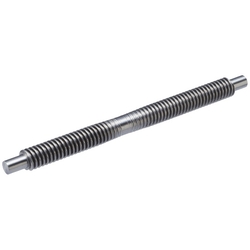
MISUMI
[Features]·One of the most commonly used 30-degree trapezoidal lead screw with double-end step type.
Shaft Shape Nominal of Thread D(Ø) Thread Position Thread Pitch(mm) Shaft Material Shaft Surface Treatment Type Tolerance of Central Part (Incomplete Threaded Portion) Screw Nut Shape Screw Nut Material Screw Nut Outer Dia. D(Ø) Screw Nut Length L(mm) Both Ends Stepped 10 ~ 50 Right and Left-Hand Thread 2 ~ 8 Steel Not Provided / Low Temperature Black Chrome Plating / Black Oxide Lead Screw Not Provided / Provided (h7) - - - - Days to Ship: Số ngày giao hàng: 6 Day(s) or more  6 Day(s) or more
6 Day(s) or more
-
You can add up to 6 items per a category to the compare list.
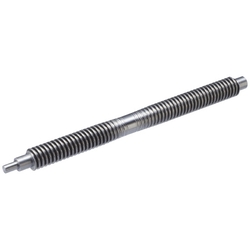
Lead Screws-One Ends Double Stpped/Both Hand Thread
MISUMI
[Features]Easy installation type into the trapezoidal lead screw support unit.
Shaft Shape Nominal of Thread D(Ø) Thread Position Thread Pitch(mm) Shaft Material Shaft Surface Treatment Type Tolerance of Central Part (Incomplete Threaded Portion) Screw Nut Shape Screw Nut Material Screw Nut Outer Dia. D(Ø) Screw Nut Length L(mm) - 12 ~ 50 Right and Left-Hand Thread 2 ~ 8 Steel Not Provided / Low Temperature Black Chrome Plating / Black Oxide Lead Screw Not Provided - - - - Days to Ship: Số ngày giao hàng: 6 Day(s) or more  6 Day(s) or more
6 Day(s) or more
-
You can add up to 6 items per a category to the compare list.
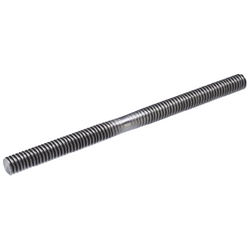
Lead Screws-Straight/Both Hand Thread
MISUMI
"Since the length is configurable in 1mm increment, the time of machining can be saved after purchasing the product."
Shaft Shape Nominal of Thread D(Ø) Thread Position Thread Pitch(mm) Shaft Material Shaft Surface Treatment Type Tolerance of Central Part (Incomplete Threaded Portion) Screw Nut Shape Screw Nut Material Screw Nut Outer Dia. D(Ø) Screw Nut Length L(mm) Straight 10 ~ 50 Right and Left-Hand Thread 2 ~ 8 Steel Not Provided / Black Oxide Lead Screw Not Provided - - - - Days to Ship: Số ngày giao hàng: 6 Day(s) or more  6 Day(s) or more
6 Day(s) or more
| BrandNhãn hiệu |
|---|
| Product SeriesDòng sản phẩm |
| CADCAD |
| From |
| Days to ShipSố ngày giao hàng |
| Shaft Shape |
| Nominal of Thread D(Ø) |
| Thread Position |
| Thread Pitch(mm) |
| Shaft Material |
| Shaft Surface Treatment |
| Type |
| Tolerance of Central Part (Incomplete Threaded Portion) |
| Screw Nut Shape |
| Screw Nut Material |
| Screw Nut Outer Dia. D(Ø) |
| Screw Nut Length L(mm) |
You can add up to 6 items per a category to the compare list. | You can add up to 6 items per a category to the compare list. | You can add up to 6 items per a category to the compare list. | |
| BrandNhãn hiệu | MISUMI | MISUMI | MISUMI |
| Product SeriesDòng sản phẩm | |||
| CADCAD |
|
|
|
| From | |||
| Days to ShipSố ngày giao hàng | 6 Day(s) or more | 6 Day(s) or more | 6 Day(s) or more |
| Shaft Shape | Both Ends Stepped | - | Straight |
| Nominal of Thread D(Ø) | 10 ~ 50 | 12 ~ 50 | 10 ~ 50 |
| Thread Position | Right and Left-Hand Thread | Right and Left-Hand Thread | Right and Left-Hand Thread |
| Thread Pitch(mm) | 2 ~ 8 | 2 ~ 8 | 2 ~ 8 |
| Shaft Material | Steel | Steel | Steel |
| Shaft Surface Treatment | Not Provided / Low Temperature Black Chrome Plating / Black Oxide | Not Provided / Low Temperature Black Chrome Plating / Black Oxide | Not Provided / Black Oxide |
| Type | Lead Screw | Lead Screw | Lead Screw |
| Tolerance of Central Part (Incomplete Threaded Portion) | Not Provided / Provided (h7) | Not Provided | Not Provided |
| Screw Nut Shape | - | - | - |
| Screw Nut Material | - | - | - |
| Screw Nut Outer Dia. D(Ø) | - | - | - |
| Screw Nut Length L(mm) | - | - | - |
Loading...Tải…
ConfigureTạo
Specification/DimensionsĐặc điểm kỹ thuật / Kích thướcĐặc điểm kỹ thuật / Kích thước
-
Shaft Shape
-
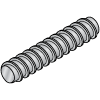 Straight
Straight -
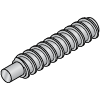 One End Stepped
One End Stepped -
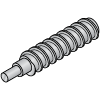 One End Double Stepped
One End Double Stepped -
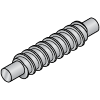 Both Ends Stepped
Both Ends Stepped -
 One End Stepped, One End Double Stepped
One End Stepped, One End Double Stepped -
 Both Ends Double Stepped
Both Ends Double Stepped
-
-
Nominal of Thread D(Ø)
-
Thread Position
- Right-Hand Thread
- Left-Hand Thread
- Right and Left-Hand Thread
- Precision Right and Left-Hand Thread
-
Thread Pitch(mm)
-
Shaft Material
- Steel
- Stainless Steel
-
Shaft Surface Treatment
- Not Provided
- Low Temperature Black Chrome Plating
- Black Oxide
-
Type
- Lead Screw
- Screw Nuts
-
Tolerance of Central Part (Incomplete Threaded Portion)
-
Screw Nut Shape
-
Screw Nut Material
-
Screw Nut Outer Dia. D(Ø)
-
Screw Nut Length L(mm)
Application example related to this categoryVí dụ ứng dụng liên quan đến danh mục này
Related Categories to Lead Screws, NutsDanh mục liên quan đến Lead Screws, Nuts
FAQ Lead Screws, Nuts
- Question: How do lead screws and ball screws differ in their applications and efficiency?
- Answer: Lead screws and ball screws differ in their applications and efficiency due to design variations. Lead screws, using a threaded shaft and nut, suit low-speed, low-precision tasks like manual adjustments. They typically exhibit lower efficiency due to higher friction. In contrast, ball screws integrate ball bearings between the screw and nut, enhancing efficiency, precision, and speed. Consequently, ball screws find favor in high-precision, high-speed applications such as CNC machining, robotics, and aerospace systems where smooth, precise motion is critical, offering superior performance compared to lead screws.
- Question: What should be considered when choosing the size of a lead screw for a specific application?
- Answer: When choosing a lead screw size for an application, consider factors like load capacity, speed, and precision requirements. Determine the necessary length, pitch, and lead based on travel distance and desired linear speed. Ensure proper end support and mounting arrangements to prevent instability. Also, consider environmental conditions, material choice, coating, and acceptable backlash levels. By carefully weighing these aspects, you can select the appropriate lead screw size to ensure optimal performance and reliability for your specific application.
- Question: What are the advantages of using a 30-degree trapezoidal lead screw with a double-end step?
- Answer: Using a 30-degree trapezoidal lead screw with a double-end step offers numerous benefits. These include enhanced load capacity, improved stability, reduced backlash for precise positioning, increased efficiency due to smoother operation, and versatility allowing for flexible design options utilizing both ends. Overall, this configuration provides strength, stability, precision, and adaptability, making it ideal for a wide range of industrial and mechanical applications requiring reliable and precise linear motion.
- Question: What distinguishes MiSUMi C-VALUE Lead Screws from standard MiSUMi products in terms of cost and quality?
- Answer: MiSUMi's C-VALUE Lead Screws offer a balance between cost-effectiveness and quality. They are priced lower than standard MiSUMi products, making them more affordable for applications where precision requirements are less stringent. While C-VALUE Lead Screws maintain a level of quality suitable for many applications, they may not offer the same level of precision and performance as standard products. This means they might have slightly looser tolerances or undergo less rigorous testing. However, they still provide a cost-effective solution for applications where moderate precision is acceptable.
- Question: What factors should be considered when selecting a lead screw for high-load applications?
- Answer: When selecting a lead screw for high-load applications, factors such as load capacity, material strength, diameter, pitch, nut design, and lubrication must be considered. The lead screw should withstand the anticipated load without deformation, requiring a material with high tensile strength and a robust nut design. A larger diameter and coarser pitch help distribute the load effectively, minimizing deflection. Proper lubrication reduces friction and wear, prolonging the lead screw's lifespan under high-load conditions, ensuring reliable performance in demanding applications.






















How can we improve?
How can we improve?
While we are not able to respond directly to comments submitted in this form, the information will be reviewed for future improvement.
Customer Privacy Policy
Thank you for your cooperation.
While we are not able to respond directly to comments submitted in this form, the information will be reviewed for future improvement.
Please use the inquiry form.
Customer Privacy Policy